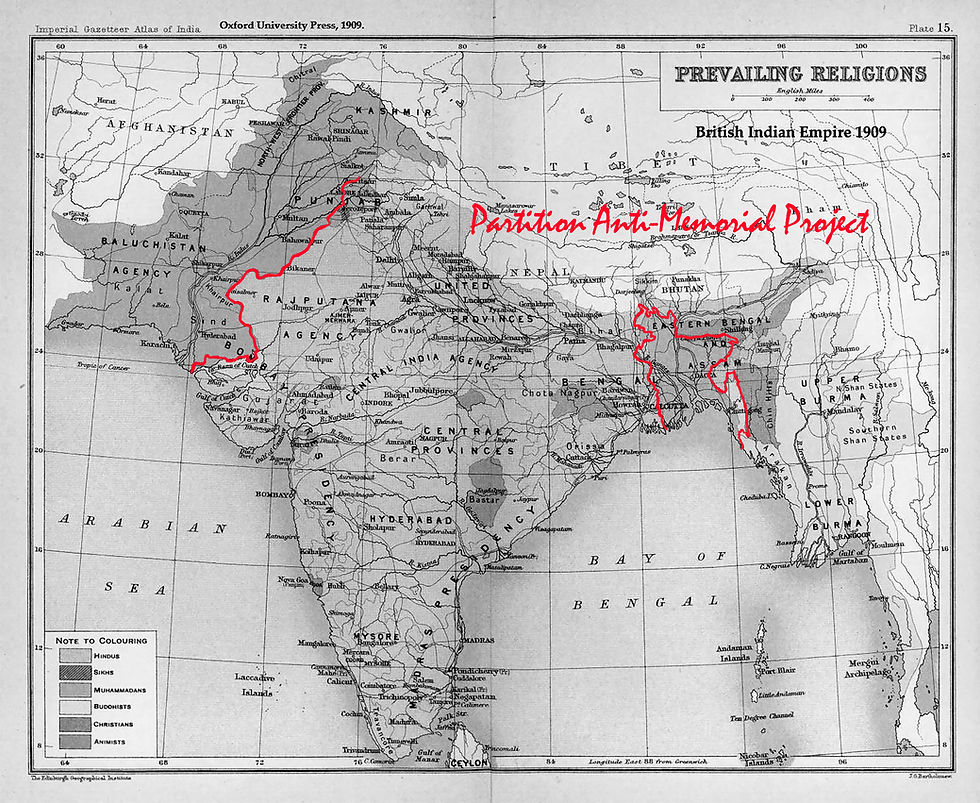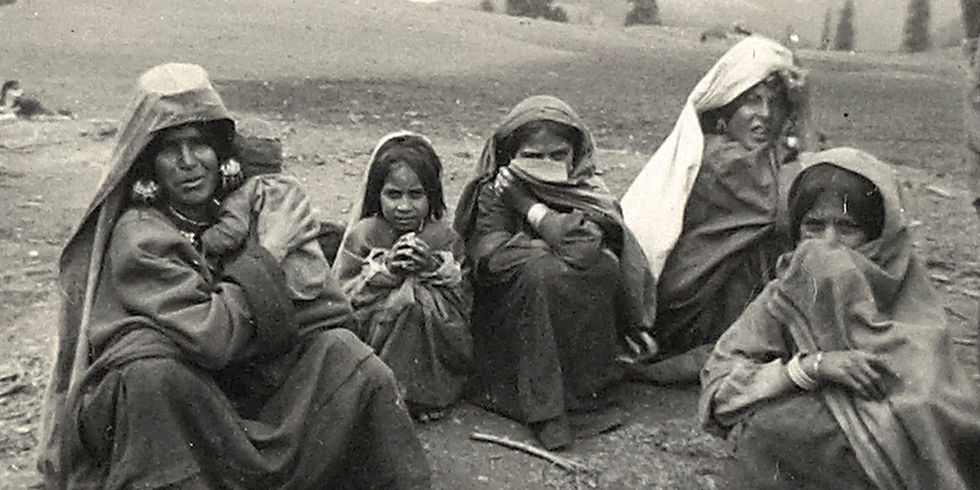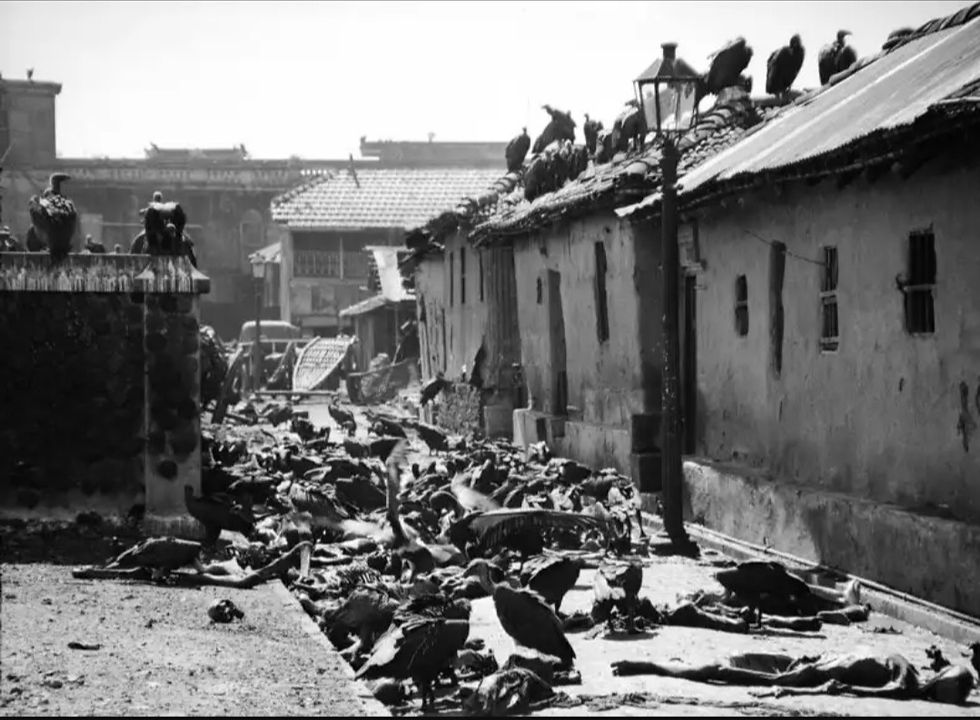British India was partitioned on August 15, 1947, to create India and Pakistan, as two independent nations. August 15, 2022, will mark the 75th anniversary of Partition. These three separate dominions became the Indian Republic, the Islamic Republic of Pakistan, and the People's Republic of Bangladesh. This restructuring was done through the partitioning of two provinces of British India - Bengal and Punjab. The Partition of India in 1947 by the British split the Indian subcontinent into India, and West and East Pakistan. Since the Bangladesh Liberation War of 1971, West Pakistan is now just called Pakistan, and East Pakistan, is now Bangladesh. 2021 marked the 50th anniversary of the creation of Bangladesh which was essentially another partition, albeit of Pakistan.

The Radcliffe Line
The Radcliffe Line was the new border between India and Pakistan, thus named after its architect, Sir Cyril Radcliffe. The Radcliffe Line divided British India into India and East and West Pakistan.
Independence and Partition, 1947
India's independence in 1947 is forever linked with its ghostly twin, the Partition. was regarded as a crucial event in British military history. The Partition was a watershed event that triggered the largest migration in the history of the world, and erupted one of the most brutal incidents of ethnic violence. The Indian National Congress leaders, Nehru, Gandhi, and others mourned the division of the Indian subcontinent but also celebrated the Indian Independence. Muslim league leaders celebrated the creation of Pakistan, a new nation.

The Bloodbath of 1947
The Partition of India was done on religious lines - Pakistan was created for the Muslims and India was to be the country for Hindus. However, this religious division triggered the most brutal communal violence in the sub-continent. As Indian Muslims rushed across the new borders to Pakistan, and as Hindus moved to India from villages and towns that were now in Pakistan, over 20 million people were displaced in an unprecedented mass migration in history. Approximately 2 million people died in the communal violence at the border. Hundreds of of Hindu and Muslim refugees found themselves in crowded refugee camps as a result of the Partition of India.
Rape as a Weapon
What is lesser known is that over 300,000 women are estimated to have been raped and sexually violated during the Partition riots. Rape was used as a weapon in the brutal Partition riots.


The End of the British Raj
The Congress opposed the British invasion and large nationalist movements ensued when British forces invaded the Indian country unconstrained by any government in 1939. In connection with this, Gandhi was held for several months and Nehru was held for several months. The British wartime need for allied locals offered a window of opportunity for the Muslim League to cooperate for the future of political safeguards. In March 1940 the Pakistan-based Muslim League called for “separate states,” infamously called the "two-nation theory."

End of Empire
Retreating from India in 1947 was one of the most important events of the British Empire. India was its main source of economic sustenance even though it had numerous colonizations to secure and protect its trade routes. More importantly, the British withdrawal was seen as a precedent in other British colonies. It accelerated the demands of independence in other colonized countries.

Self-Government
In World War II (1939 – 1945) Indian soldiers fought alongside British soldiers in the British Army. Britain's coffers were drained by the second world war, but it could not have fought the it without the loyal support of Indian soldiers. India's goal to establish Indian independence began with the Indian Mutiny (1857 – 1959). India has become increasingly invested in gaining autonomy for war contributions. However, it also led to serious intercommunal violence among Hindus, Sikhs and Muslims. The British government decided on giving independence to India as part of their exit strategy from India. Although talks had been ongoing between the Indian National Congress and the Muslim League, they were unable to agree on the shape of the new government.

Partition as a Colonial Solution
Eventually Britain found that dividing only solved a few problems. On June 2 1947 the late Admiral Lord Mountbatten said the British accepted the split between a mainly Hindu India and a mainly Muslim Pakistan. During the election, the Princely states in India were allowed to choose which nation they wanted to join. Some states in India and Pakistan where princes were not able to join either had to pick another country. The partition saw division of Indian military branches, including the Royal Indian Navy and the Royal Indian Army. The British Army of India thus became the Indian Army and the Pakistani Army.

Divided Subcontinent and Kashmir
In the immediate following of India's independence tension grew. The first of three major conflicts between the two countries exploded in Kashmir. The Maharaj was not willing to come to India or Pakistan. Therefore Pakistan supported tribal invasions that were intended for an annexation of this nation. In 1944 Naik Nand Singh won the Victoria Cross in the Kingdom of Burmania, but fought Pakistanis against Pakistan's forces in Kashmir, and in 1947 he was shot dead.

Why did the Partition of India happen?
The partition of India was on religious terms and was founded by dividing two regions – Bengal – which is the largest province in India – Punjab. Hindus and Sikhs fled Pakistan because they wanted a life that was not Muslim-controlled. And Muslims fled India, because they wanted to be in a Muslim majority nation. Who was responsible for the Partition of India?
The British bear most of the responsibility for the Partition of India. However some argue that if the Indian National Congress and the Muslim League could have reached a compromise, the Partition may have been avoided. This is an oversimplification though, because the British had turned the Hindus and Muslims against each over years of political conniving.
What happened during Partition of India?
The Partition of India in 1947 by the British rule split the Indian subcontinent into India, and West and East Pakistan. Since the war of 1971, West Pakistan is now just called Pakistan, and East Pakistan, now Bangladesh. These three separate dominions became the Indian Republic, the Islamic Republic, and the People's Republic of Bangladesh. The restructure was done through the partitioning of two provinces of British India - Bengal and Punjab.
Why was India split into two countries?
Ostensibly to create communal harmony between Hindus and Muslims, the British divided the Indian subcontinent into India and Pakistan. However, the British had been stoking communal differences and creating communal conflict between Hindus and Muslims for decades which led up to the Partition as an inevitable and only option for an independent India.

Partition Anti-Memorial Project
Artist Pritika Chowdhry founded the Partition Anti-Memorial Project in 2007, on the 60th anniversary of the Partition of India. It comprises of several art installations that memorialize the traumatic geopolitical event of the Partition of India in 1947. Each art installation is an anti-memorial that unpacks a different facet of the Partition. These rigorously researched anti-memorials excavate the traumatic counter-memories of the Partition of India in multiple registers. To commemorate the 75th anniversary of the Partition, the Partition Anti-Memorial Project is featured in a solo retrospective exhibition by Pritika Chowdhry at the South Asia Institute, titled "Unbearable Memories, Unspeakable Histories."
Είναι όντως ένα από τα πιο σύνθετα και τραγικά κεφάλαια της σύγχρονης ιστορίας. Η διαίρεση της Ινδίας το 1947 προέκυψε μέσα από ένα κράμα πολιτικών πιέσεων, αποικιοκρατικής βιασύνης και θρησκευτικών εντάσεων. Η βρετανική αποχώρηση έγινε γρήγορα, χωρίς επαρκή σχεδιασμό, και η γραμμή Radcliffe χαράχθηκε σε λίγες εβδομάδες, βασισμένη σε ασαφή δεδομένα. Αυτό είχε ως αποτέλεσμα εκατομμύρια άνθρωποι να βρεθούν "ξένοι" στη χώρα τους από τη μια μέρα στην άλλη, προκαλώντας βίαιες μετακινήσεις, σφαγές και προσφυγικά κύματα. Το τραύμα αυτό είναι ακόμα ζωντανό στη μνήμη και τις πολιτικές των δύο χωρών. Αν θες να κατανοήσεις κάτι τόσο πολύπλευρο, είναι σημαντικό να δεις την κάθε πλευρά χωρίς προκατάληψη, όπως κάνουμε όταν εξετάζουμε με αντικειμενικότητα τις μέθοδοι πληρωμής https://tychebets.gr/kritikes/slotsgem-casino σε μία πλατφόρμα –…